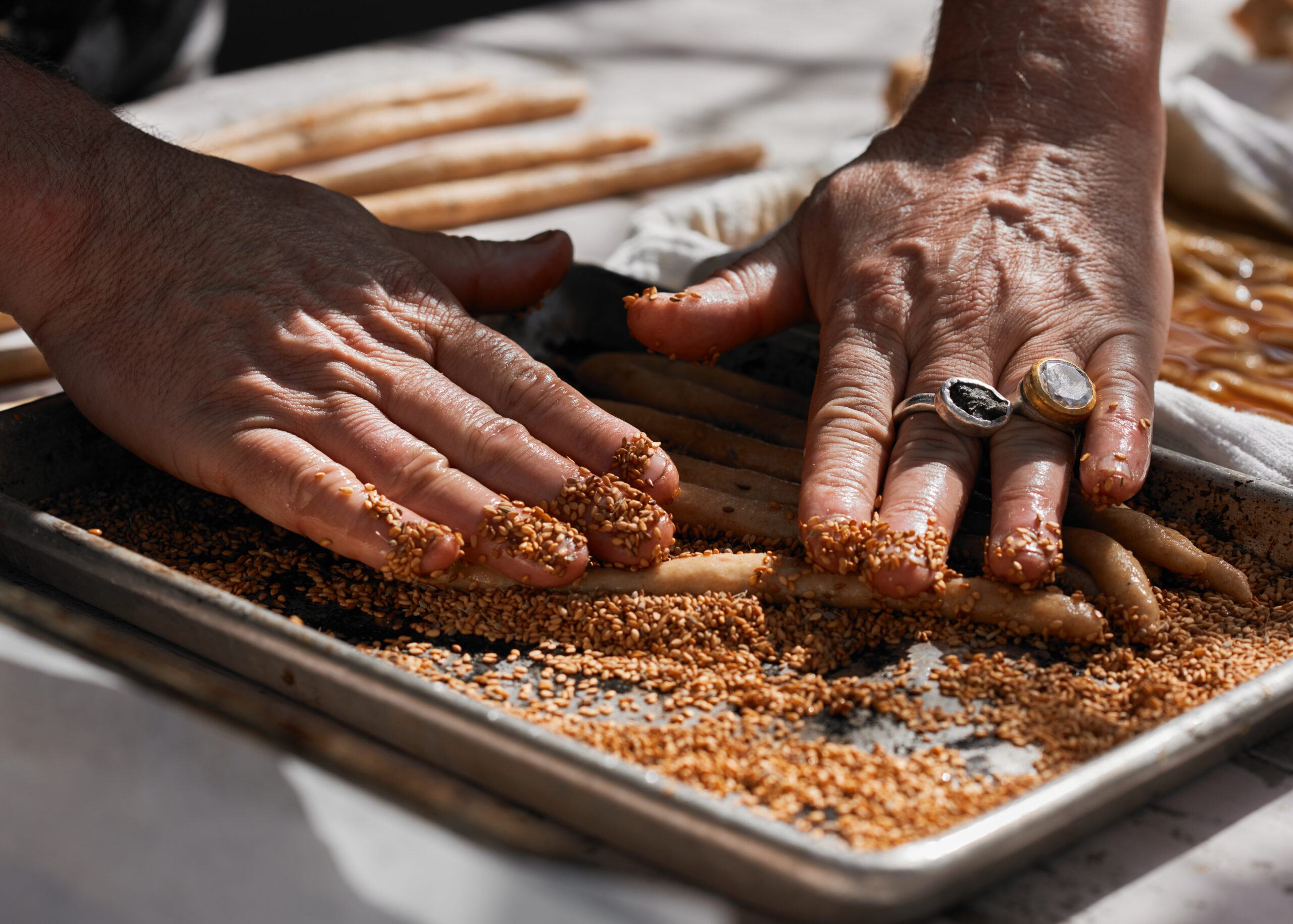Just how long did it take Uri Scheft to knead a challah dough made with heritage flours? And, how are local ancient wheat varieties connected to the war in Ukraine in Erez Komarovsky’s mind?
For Asif’s “A City, Wheat, Bread” exhibition, we set out to examine heritage wheats and the breads and pastries that can be made with them. We invited leading professional and local home bakers to experiment with different types of flour, and share the recipes. Five of the bakers also shared their reflections on working with ancient wheat varieties — and whether you’ll see these loaves and pastries at a local bakery anytime soon.
Michal Bouton, Amita
A pastry chef and co-owner of Amita bakery in Yaffo, Michal integrates local techniques and ingredients into the European baking tradition that’s popular in Israel. She made a modern recipe for this project, inspired by the traditional aljerk bread, resembling a filled challah dough.
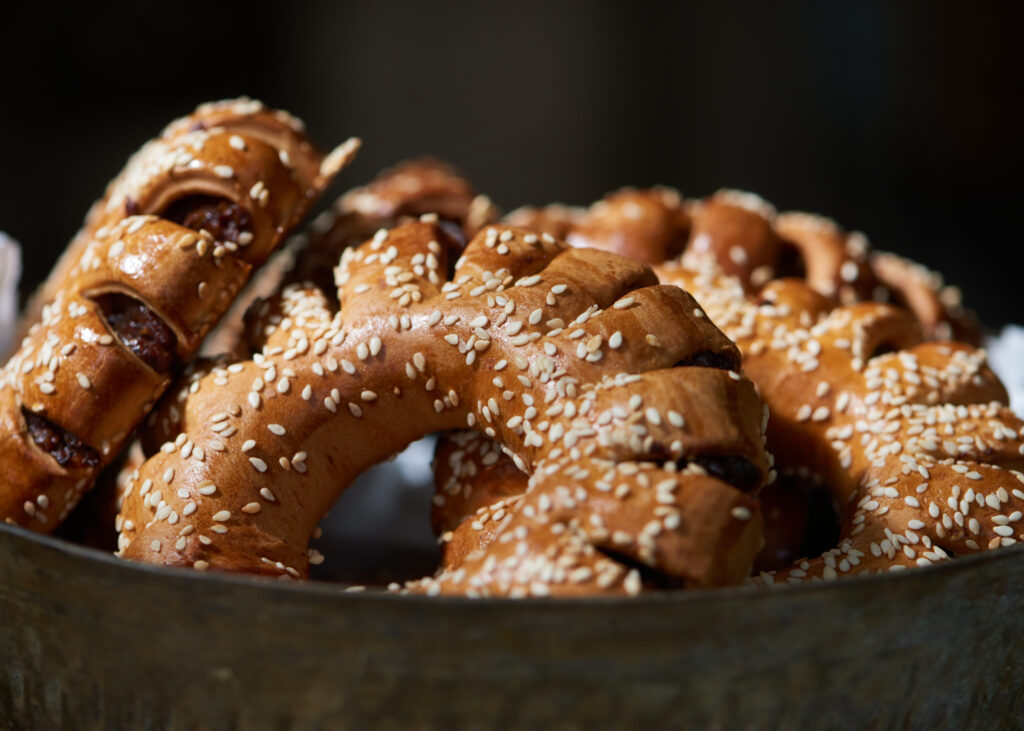
What do I find exciting about baking with heritage wheat varieties?
We were thrilled at the bakery when we heard about this project. We were excited about this sort of romantic presentation of baking, the opportunity to try and recreate ancient recipes and perhaps learn some new things. We hoped to discover an ingredient we have never worked with, a really unfamiliar, fresh flavor.
How did the baking go?
Out of the three flours we received, one was for bread, and it did succeed in giving the loaf a stable, full body. The experience was very thrilling and exciting – but for us, it was mainly an experiment. As the flour is not available in large quantities for commercial use, we will have to settle for the familiar white flour when we make this pastry for the general public.
Hagay Ben Yehuda, Hagay’s Bread
Hagay is a fifth-generatin baker who owns an artisanal bakery in kibbutz Einat that specializes in breads made with natural sourdough from flour, salt, and water. Hagay is a baker of the nostalgic, romantic kind, just like in a children’s book – a farmer-baker who grows heritage wheat varieties and collaborates with Israel’s Volcani Center in researching the nearly extinct varieties of local wheat. For this project, he baked taboon-style bread.

What do I find exciting about baking with heritage wheat varieties?
To try and reproduce what happened here 400 years ago thrills me. There was no yeast and no white flour. Discovering that old dough was used as a leavening agent and that ancient wheat varieties were not milled and sifted in the same way they are today, led me to a better understanding of the process of baking bread. Unlike other ingredients, you cannot taste the flour before baking, so it is always exciting to bake with a new type of flour, and each time I sliced and tasted a bread it was like opening an ancient treasure chest. I didn’t know what to expect and had nothing to compare to.
What was your baking experience like?
Baking a taboon bread, in a real stone taboon heated with olive waste, turned out to be a fascinating experience. The bread is really a local focaccia from local flour, baked in a local taboon, which is the most logical and right kind of bread to consume. The bread I chose to make can still be found in specific bakeries in East Jerusalem and the cities of the West Bank. I used chickpea water as my leavening agent — it had a strong smell of fermentation, which initially raised some doubts. I think we are conditioned towards uniformity from an early age — uniformity in the shape of stalks and field, in the color and texture of the flour, and also in the flavor and texture of bread. We have become so accustomed to it that it’s very hard for us to accept breads with strong or different flavors and aromas. But the longer I worked with the dough, the stronger the sourdough became, I felt the quality of the bread improve. Also, realizing that sugar was used historically, albeit less frequently and in smaller quantities, led to a far better result than I had imagined.
I hope these flours become more available. Personally, I would certainly prefer to use local wheat, which can be sustainably cultivated in the local climate, contribute to biodiversity, and cause less harm to the environment.
Safa Bushnak, Kafr Manda
A music teacher by profession, Safa first entered the world of baking 13 years ago, when her husband asked her to make manakish (a flatbread topped with za’atar) and she wasn’t happy with the result. She could not stop thinking about it, and returned to the recipe quickly, determined to get a perfect result. She’s baked every day since, deepening her knowledge through books, vidoes, baking workshops, and experimenting with a variety of flours. Today, she leads baking workshops on sourdough and pastry.
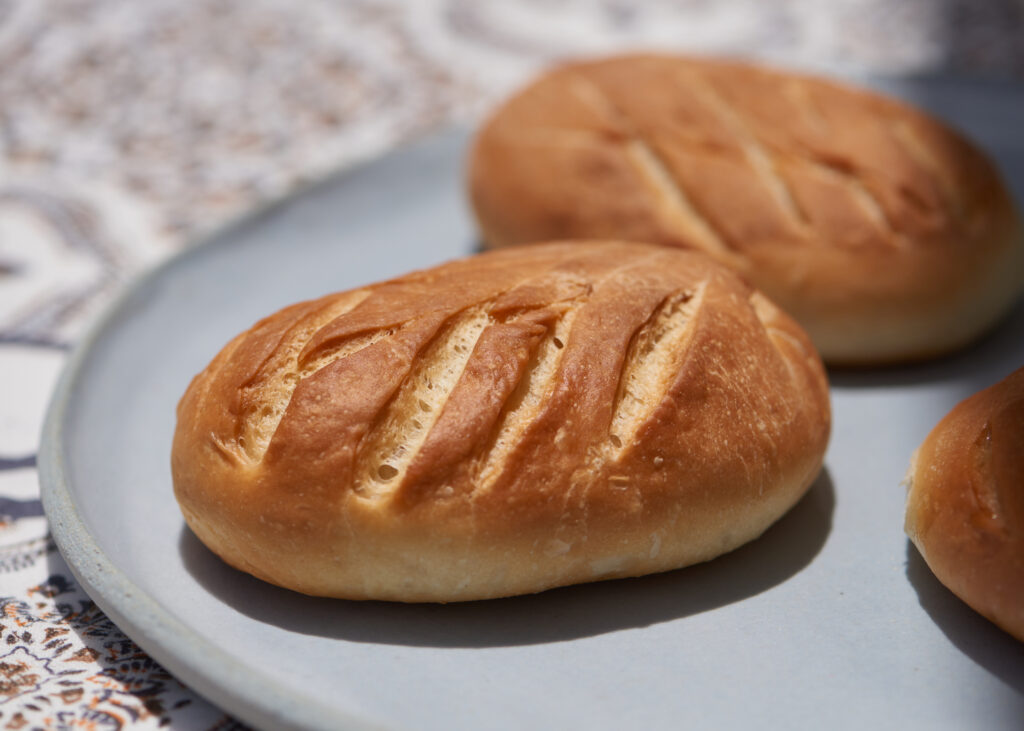
For this project, she recreated historic recipes, which were popular in Jerusalem in the 17th century including mawi, a flat bread made in a skillet and samuni (sometimes spelled samuni) which resembles a rolle or a baguette, (in the Arab world, the term “samuni” is now used for all types of rolls).
What do I find exciting about baking with heritage wheat varieties?
The fact that you can use two simple, accessible ingredients like flour and water to make an endless variety of unique breads. I was thrilled about the idea of working with a local flour that was used by my ancestors. I use special flours in my baking, but these ancient varieties inspired me to think of the experience of past bakers as they made their staple food.
How was the baking experience itself?
The flours were easy to work with and comfortable to knead, like clay. Shaping was easy too: the gluten was very dominant, and it kept the shape stable. The mawi bread was very simple to make and turned out so beautifully that I regretted making it in the morning of a fast day. The temptation was hard to resist. With a swirl of good tahini and dibs (grape syrup), it was simply divine. I tried to make the samuli bread as rustic as possible, so I didn’t score it with a knife, and kept its shape simple. When it was in the oven, I was surprised to find out it had a different aroma than the breads I usually make, and the taste was different, too. Even my young kids recognized the difference. I guess our palate has become so accustomed to the uniform flavor of contemporary flours, that we immediately find other flavors strange.
Erez Komarovsky, Matat
A baker and one of the owners of the Erez and Hanan catering company, Erez was one of the firsts to introduce sourdough breads and their unique flavor to the general Israeli public. Many of us fell in love.
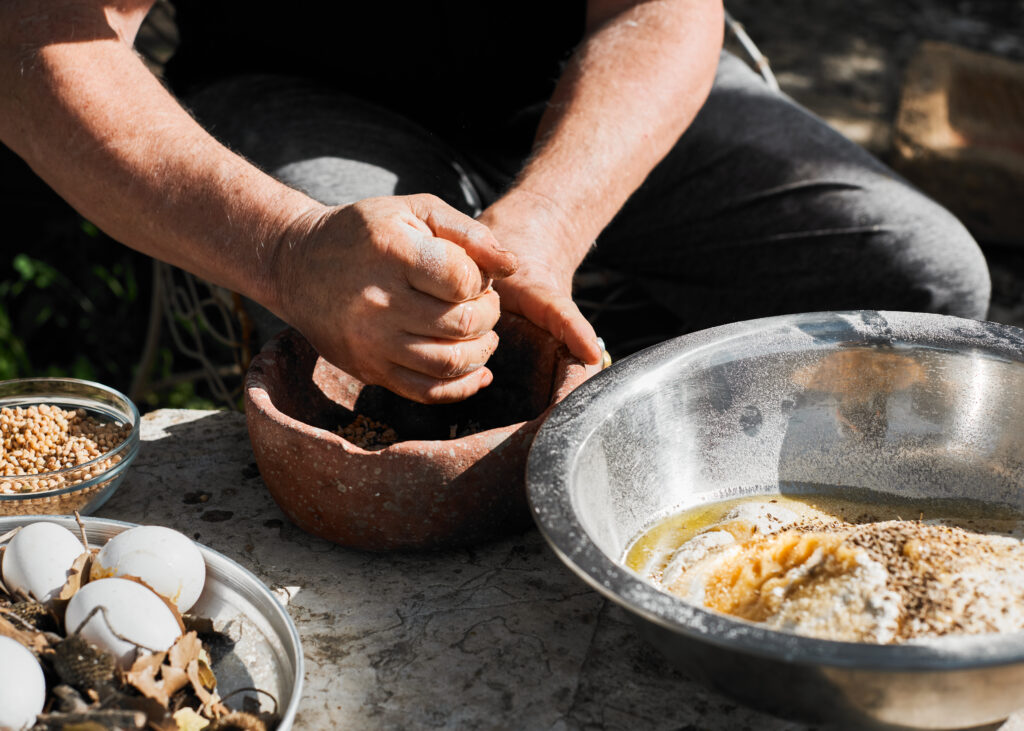
For this project, he baked a sesame bagel that feels like the ancestor of the iconic Abadi biscuits. These sweet-savory cookies are common in Palestinian communities in Nazareth and East Jerusalem and are particularly popular during Ramadan.
What do I find exciting about baking with heritage wheat varieties?
This return to local flours makes me happy. I believe in food localism, so for me, this is a revolution. Especially with the war going on in Ukraine, one of the world’s top producers of wheat, and the source of one fourth of the flours consumed in Israel. There’s been a sharp increase in flour prices and a decrease in availability.
Here, suddenly, we have a completely different approach to flour, with the wheat milled just before baking. The taste and aroma of freshly milled flour made from locally grown wheat, this is another step towards authenticity in local food. The flour should be local, and the same goes for olive oil, goat cheese, etc.
What was the baking experience like?
I used the flour to make a very oily, rich dough which requires quick kneading, and the resulting dough was very tasty thanks to the flour, with a real earthy flavor. Rolling the dough into ‘snakes’ felt very communal to me, I could close my eyes and imagine a group of women performing it together. The flour is suitable for flatbreads, taboon breads baked in high heat. This experiment was in tune with my personal development as a baker, as I hardly ever make sourdough breads anymore.
Uri Scheft, Lehamim
Baker Uri Scheft is owner of the Lehamim bakery and a long-time researcher of challah, which he baked for this project. He made a round loaf with flour, water, and yeast, and enriched it with eggs and olive oil.
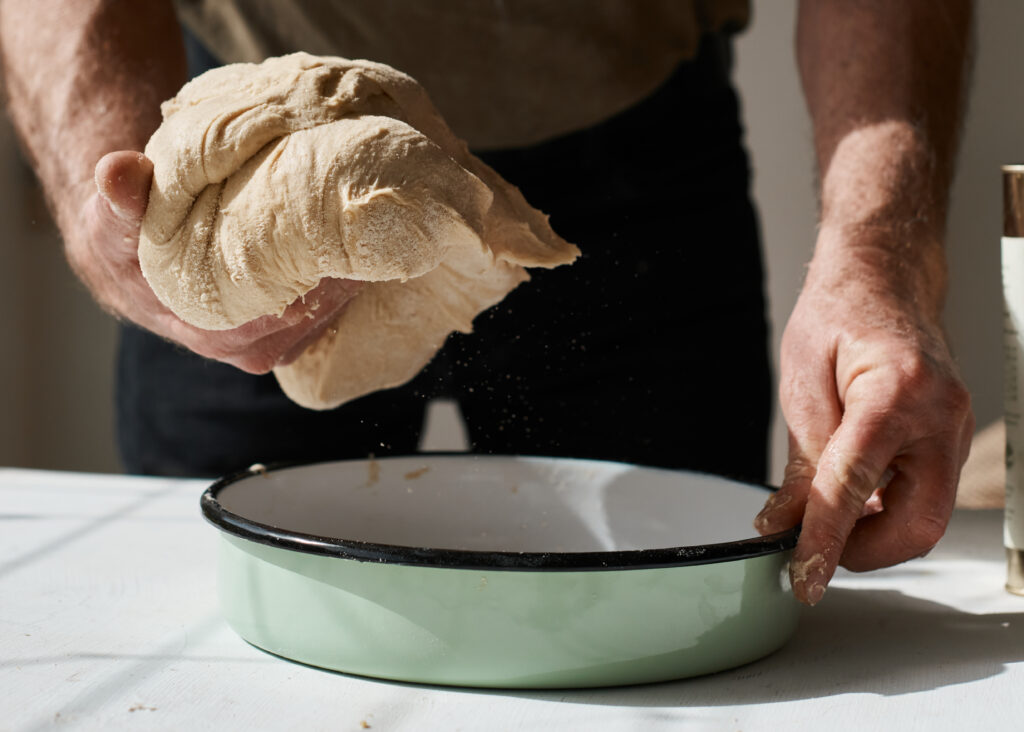
What do I find exciting about baking with heritage wheat varieties?
I want to find out what long-term effects they can have on gluten sensitivity, to see if certain varieties don’t cause such sensitivities, both in the wheat level and in the technological-industrial aspect related to milling.
Tell us about your experience baking this challah.
Kneading was an hours-long process of stretching and folding, very different from the modern technique. I wonder whether such flours can find a market here in Israel. I believe they can, as people worldwide have a growing awareness of the food they eat. Consumers want more information about the ingredients they consume, and there is a growing interest in heritage flours, motivated by the curiosity of chefs and food professionals. I am certain this process will eventually reach consumers, too, even if it takes time and is limited to small, boutique bakeries in the beginning.
Meanwhile, we must take the cost into account: In the US, I purchase rye flour from a mill that works with ancient varieties, and it seems their customers are mostly home bakers and boutique bakeries. The high cost of these flours makes them unprofitable for industrial bakeries. I’m afraid that despite my true wish to integrate more heritage flours into my bakeries, I will have trouble making customers pay more for a loaf of bread, when the cost of flour alone is ten times higher or more.
